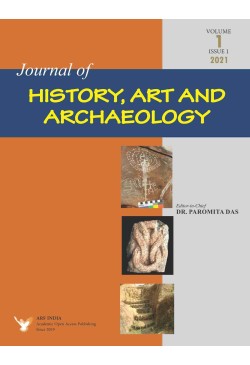
Journal of History, Art and Archaeology
Frequency :Bi-Annual
ISSN :2582-9637
Peer Reviewed Journal
WHAT IS WRONG AT THE ROYAL COURT? - THE LITERARY TESTIMONY OF HUON DE BORDEAUX
Drawing from a variety of literary texts, and especially from the thirteenth-century Huon de Bordeaux, this study argues that the concept of medieval kingship was rather tenuous. More often than not, poets of courtly romances and heroic epics depict the king as a negative figure, evil in character, irrational, unpredictable, untrustworthy, and outright vicious and violent in his actions against detractors and opponents. We cannot universalise this phenomenon, but there is solid evidence for the existence of a long-term discourse on unfit kings who threatened the well-being of their subjects because of their tyrannical attitudes, administrative incompetence, and lack of wisdom. We regularly learn of deeply concerned court councillors who try to advise the king to pursue a different policy, to observe law and order, but they are disregarded and cannot prevent the king from committing serious mistakes and acts of violence which threaten the protagonists’ very existence.
Keywords: evil kings, middle ages, Huon de Bordeaux
Classen, A. (2022). What is Wrong the Royal Court?- The Literary Testimony of Huon De Bordeaux. Journal of History, Art and Archaeology, 2: 2, pp. 127-134. https://doi.org/10.47509/JHAA.2022.v02i01.01
THE VISNU IDOLS OF VALMIKI NAGAR, BIHAR
Kumar, M., & Ara B. (2022). The Visnu Idols of Valmiki Nagar, Bihar. Journal of History, Art and Archaeology, 2: 2, pp. 135-141. https://doi.org/10.47509/JHAA.2022.v02i01.02
THE HORSE - FACED LION AN ICONOGRAPHIC ENIGMA OF THE MEDIEVAL BENGAL TERRACOTTAS
Debnath, G. (2022). The Horse – Faced Lion an Iconographic Enigma of the Medieval Bengal Terracottas. Journal of History, Art and Archaeology, 2: 2, pp. 143-148. https://doi.org/10.47509/JHAA.2022.v02i01.03
SURGICAL INSTRUMENTS AT THE ALAHANA PARIVENA HOSPITAL IN POLONNARUWA
Indigenous medicine systems in India and Sri Lanka and China have been well developed for many hundreds of years. Equally, illnesses of all kinds and results of violence and tumour formation are known to have existed. The Alahena Parivena hospital at Mihintale, is near one of the old capitals of the Sinhalese kingdom at Polonnaruwa, the capital of Sri Lanka after the destruction of Anuradhauram. The discovery of instruments found there - around 900 years old - so closely resemble modern surgical instruments that one can deduce the different types of surgery practiced at that time. They must have treated injuries, tumours, and many conditions similar to what modern surgeons deal with now. Anaesthesia may have been opiates, hypnosis, and tolerating some pain. The discovery of these instruments - a bigger collection than found anywhere else - provides physical evidence of what must have been done and is therefore a very important addition to the history of medical science in ancient South Asia.
Keywords: Surgical instruments, Poonnaruwa, Sri Lanka
Aluwihare, A (2022). Surgical Instruments at the Alahana Parivena Hospital in Polonnaruwa. Journal of History, Art and Archaeology, 2: 2, pp. 149-158. https://doi.org/10.47509/JHAA.2022.v02i01.04
CONTRIBUTION OF O.C. GANGOLY AND S.K. SARASWATI TO THE JOURNAL OF THE GREATER INDIA SOCIETY: A STUDY
Ganguly, D. (2022). Contribution of O.C. Gangoly and S.K. Saraswati to the Journal of the Greater India Society: A Study. Journal of History, Art and Archaeology, 2: 2, pp. 159-166. https://doi.org/10.47509/JHAA.2022.v02i01.05
THE TRIPURA SAMHARA NARRATIVE IN VIJAYANAGARA PAINTINGS AT HAMPI